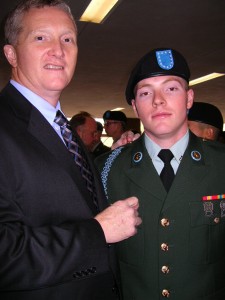 Veterans who have served since 2001 have experienced much higher rates of unemployment than their non-veteran peers, or veterans who served before them. The problem is especially elevated for female and minority veterans aged 18 to 25 years. With efforts to decrease global military involvement, many more will return to the workforce.
Veterans who have served since 2001 have experienced much higher rates of unemployment than their non-veteran peers, or veterans who served before them. The problem is especially elevated for female and minority veterans aged 18 to 25 years. With efforts to decrease global military involvement, many more will return to the workforce.
Challenges faced by 18-25 year-old veterans today will transition with them as they mature. The natural process of aging will further complicate their lives and place a larger burden on existing veterans’ programs and services that are already spread thin.
When they can’t find meaningful employment, some veterans will choose to pursue a college education with government support (the GI Bill in the U.S., for example). Job seekers fare better with a college degree — especially without the added burden of student loans, but they will have lost the income and experience earned had they been able to find jobs (which translates to financial shortcomings as their lives progress; delayed retirement, etc.). Many who sought military careers were never academic achievers and may lack the aptitude or confidence necessary to succeed in college. Some of them will gravitate toward security occupations which require technical aptitude and a commitment to continued vocational training.
Since 2001, more veterans have filed for disability benefits than ever before. Forty-five percent who served in Iraq and Afghanistan have sought compensation for service-related injuries. The increase is attributed to a combination of factors, including the way desert-era wars are fought, advances in medical care on the front line, and the lack of jobs. Injury by improvised explosive devices or IED’s—commonly used in desert conflicts—can lead to the loss of digits and limbs, traumatic brain injury (TBI), blindness, and hearing loss. In previous wars, IED’s often killed soldiers. However, advances in field medicine have now made it possible to survive—disabled, but otherwise healthy. The number of service-related mental disabilities has increased due to improved diagnostics combined with an increased number of possible diagnoses, including those associated with TBI and post traumatic stress disorder (PTSD), including PTSD related to sexual-trauma (Marchione, 2012; Maze, 2012).
 Assistive technologies (AT) help people with a range of disabilities succeed in the workplace and compete for jobs, but they require expert assessment and ongoing training. There is a critical shortage of vocational technology trainers throughout the world—especially those with an understanding of and experience with technology for people with disabilities.
Assistive technologies (AT) help people with a range of disabilities succeed in the workplace and compete for jobs, but they require expert assessment and ongoing training. There is a critical shortage of vocational technology trainers throughout the world—especially those with an understanding of and experience with technology for people with disabilities.
While few STEM scholars are AT experts, some challenges faced by people with disabilities could be overcome with low-tech or available solutions that could be easily devised or identified by a STEM scholar who is fulfilling their pay-it-forward obligation through volunteerism. By volunteering to help at vocational technology training centers or veteran’s centers, STEM scholars have an opportunity to engage with people they might otherwise never meet.
By understanding the challenges faced by veterans, STEM-Trek hopes that scholars will fully consider their needs in the future when developing new tools, technologies, and bio-medical advances. Some scholars, having had the opportunity to see how individuals struggle with basic tasks may choose to augment their scholastic track with additional expertise in the realm of veteran’s affairs or disability support. All STEM-Trekkers will emerge from their volunteer experience with heightened social awareness.
Photo, left: STEM-Trek Adviser and Treasurer Walter Walker, Jr. (left).
